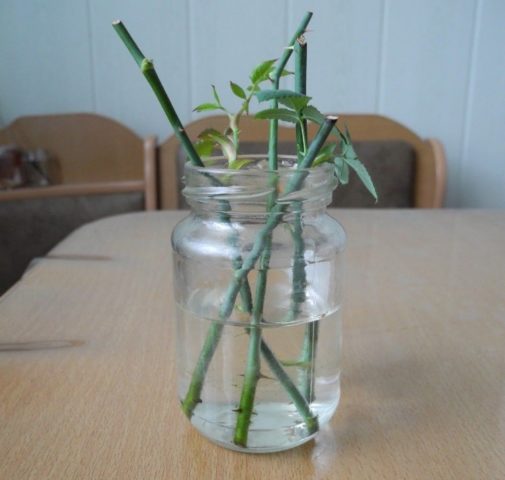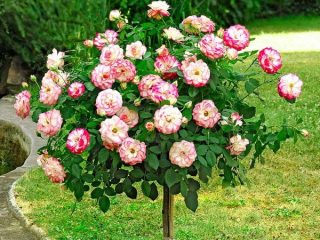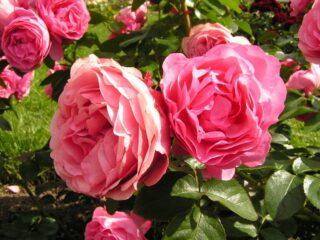Content
- 1 Breeding history
- 2 Description of the variety of Canadian park rose John Franklin and characteristics
- 3 Advantages and disadvantages of the variety
- 4 Reproduction methods
- 5 Planting and caring for a park rose John Franklin
- 6 Pests and diseases
- 7 Application in landscape design
- 8 Conclusion
- 9 Reviews of the Canadian park rose John Franklin
Rose John Franklin is one of the varieties that is appreciated not only by landscape designers, but also by gardeners. The high level of decorativeness of the culture, its characteristics allowed the plant to gain fame all over the world.
Breeding history
The work on Canadian roses began in the 19th century by the breeder William Sanders, who seeks to develop frost-resistant hybrids. His work was continued by colleague Isabella Preston.
The breeder sought to create not only a frost-resistant, but also a picky hybrid. In total, Isabella Preston has bred over 20 Canadian roses.
In the 50s, the government of Canada allocated funds for a program to breed frost-resistant hybrids. This led to the creation of two large groups in the Morden and Ottawa research laboratories: Explorer and Parkland.
John Franklin belongs to the Explorer series. It was bred in 1970 by crossing the roses Lili Marlene, Red Pinocchio, Joanna Hill and Rosa Spinosissima altaica. The variety became widespread in the world in 1980.
Description of the variety of Canadian park rose John Franklin and characteristics
In height, the hybrid reaches 100-125 cm. Leaf plates are medium in size, rounded in shape, green in color. On the stem of the shoots, yellowish or green thorns.
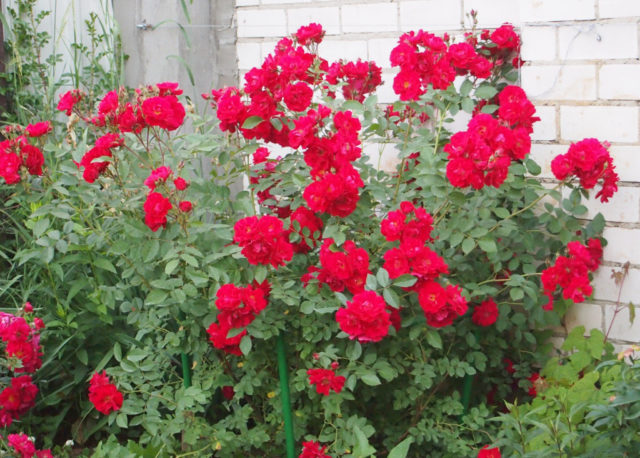
Sprawling bush, up to 110-120 cm wide
On each of the branches, from 3 to 5 buds of rich crimson or red shades are formed. Unusual for roses the appearance of flowers, they are semi-double, with pointed petals, which from a distance makes them look like a carnation. The diameter of each bud is 5-6 cm. Roses are characterized by a spicy aroma.
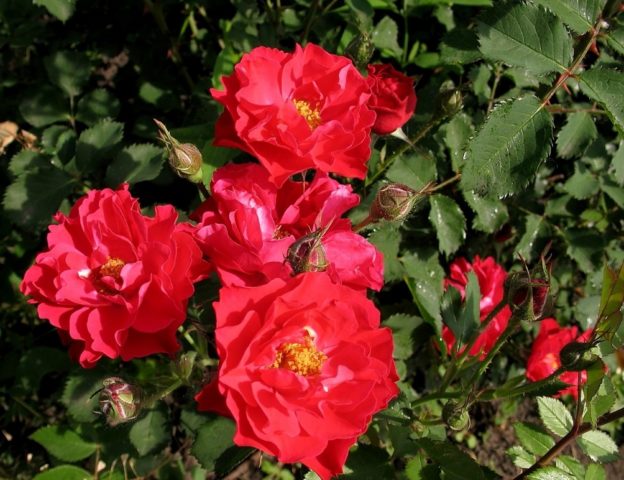
Up to 25-30 petals are formed in each flower
The buds appear on the shoots throughout the summer season, from July to late September, before the onset of frost.
It is recommended to cultivate the variety in the North-West of Russia, in the Middle Urals or South Siberia. The bush is able to withstand frost down to - 34-40 ° С.
Advantages and disadvantages of the variety
Park rose John Franklin, according to photos and reviews, matches its description. Most gardeners, when cultivating the variety, have revealed the following advantages:
- resistance to temperature changes;
- prosperous development and flowering in partial shade;
- trouble-free propagation by cuttings;
- buds wilt 15-20 days later than other varieties;
- abundant flowering;
- tolerates dry periods well;
- unpretentious care;
- cleans itself of wilted buds;
- recovers quickly after pruning.
Disadvantages of a hybrid:
- the presence of thorns;
- average resistance to fungal diseases.
Most gardeners note that although the plant can withstand cold temperatures, frost can damage its stems. Rose John Franklin recovers quickly, but blooms less abundantly during the season.
Reproduction methods
You can increase the number of bushes in several ways: by cuttings or grafting. The latter method is rarely used. Propagation by cuttings allows you to preserve the varietal characteristics of the plant, and the young bush will have stronger immunity than seedlings obtained by grafting.
Cuttings should be carried out in the last week of June or early July. You can cut the cuttings in the fall, and then leave them in a cool room over the winter to start breeding in the spring.

If necessary, you can store cuttings of the John Franklin rose in the refrigerator, periodically moistening them and checking for mold.
Algorithm of actions:
- Pour fertile soil mixture into the box.
- Cut the shoots of roses into 12-15 cm in length.
The lower leaf plates should be removed, and the upper ones should be slightly shortened.
- Transfer the workpieces to moistened soil, cover the container with foil or glass.
The cuttings should be ventilated daily, condensation should be removed from the shelter.
If the cuttings grow and take root, then the procedure is done correctly. Young roses should be transplanted outdoors.
Planting and caring for a park rose John Franklin
If the root system is closed, then you can plant a bush both in spring and autumn. When the roots are not protected, it is not recommended to plant the variety in the autumn months: the rose may not have time to take root if the frosts start early.
The seedling should be purchased from trusted suppliers or in specialized stores. The selected rose must be grafted. There are no signs of rot, plaque, cracks on it.
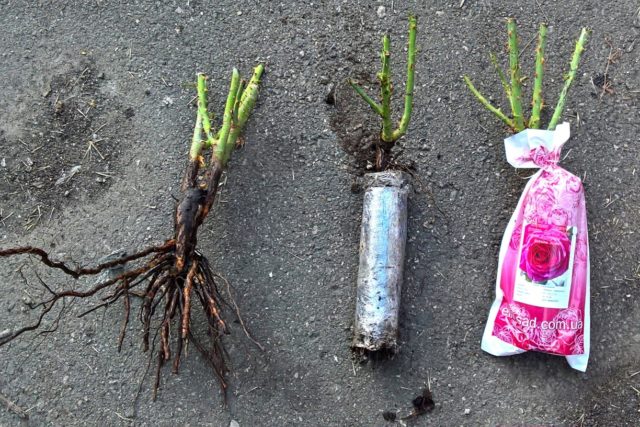
If the seedling has closed roots, then such John Franklin roses will take root faster than samples with an open root system.
On the site for the variety, a ventilated, well-lit by the sun, place should be allocated. It is allowed to plant the plant in light partial shade.
The optimal soil composition for John Franklin's rose is fertile and loose soils. The medium should be neutral or slightly acidic.
To prepare a place for planting, it is necessary to dig up the earth, put peat, ash and humus into the ground to a depth of 2 bayonets of a shovel, and leave it for several days.
Landing Algorithm:
- Cut off the tops of the shoots by 1-2 cm. Treat the roots with a growth stimulant.
- Dig a hole so that the roots of the bush can be straightened. When planting several roses, a distance of 1 m between the pits should be observed.
- At the bottom of the hole, lay out a drainage layer of small pebbles, broken brick.
- Fill the hole 2/3 with a soil mixture of earth, ash, peat.
- Place the John Franklin rose in the hole, sprinkle it with soil, deepening the grafting site by 10 cm.
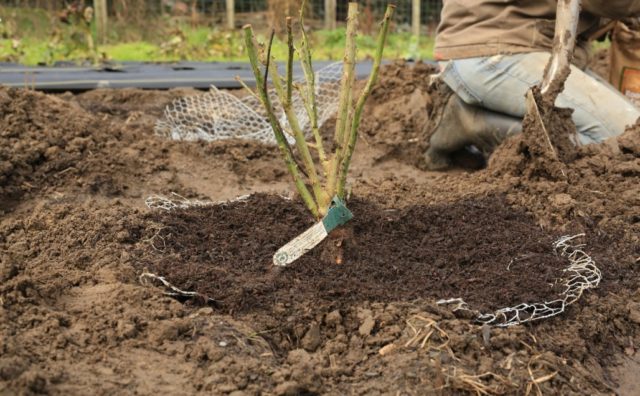
At the end of the work, water the plant abundantly, mulch the ground around it using sawdust or tree bark
Caring for the John Franklin rose variety consists in timely watering, loosening, and top dressing. It is recommended to use complex products as fertilizers. They must be applied to the soil three times, 14 days after planting, in the middle of summer and in autumn. Pruning the bush is not required: it is enough to remove damaged shoots in the spring.
And although Canadian roses do not need shelter, the John Franklin hybrid is less stable than the rest of the group. Flowering will be more abundant if the bush is covered for the winter.
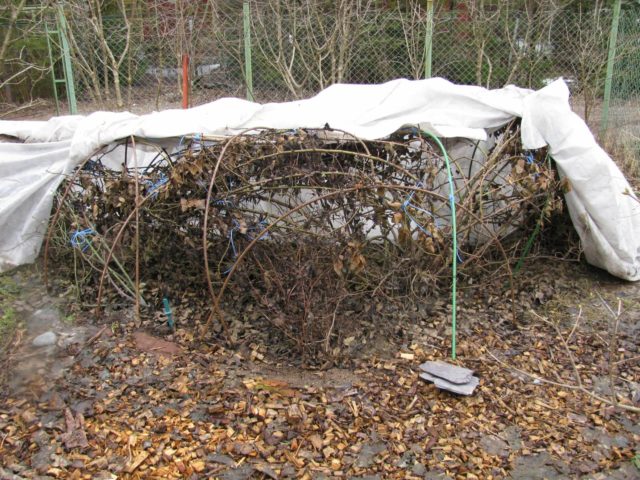
Before covering the branches with improvised materials (cloth or spruce branches), it is recommended to spud the plant
Pests and diseases
If the integrity of the stem is damaged or an infection develops, there is a risk of burns or cancer. A yellow spot, swelling or growths appears on the shoot.

When an affected area is identified, it is cleaned and covered with garden pitch, or the shoot is completely removed
If cancer is diagnosed at the "tumor" stage, then treatment is meaningless. The bush will have to be dug up and burned to protect other plants.
Rust is characterized by the appearance of a yellow powder on the sheet plates. If the leaves turn brown, this means that the development of the disease is in full swing, and it will appear next year.
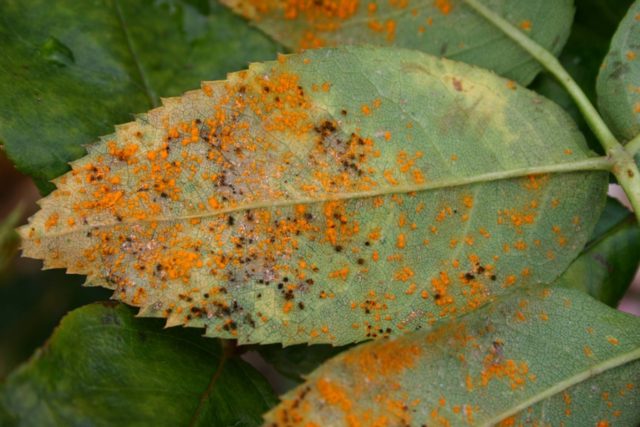
As a treatment for rust, it is recommended to treat the bush with Fitosporin or Fundazol
Brown or black spots that appear on the leaf and gradually merge together are a sign of black spot.Leaf plates, as the disease progresses, twist and wither, fall off.

As a therapeutic measure, all affected parts of the rose should be removed and burned, the bush should be treated with Skor
When affected by powdery mildew, the leaves of the flower are covered with a whitish bloom. If you do not start treatment in a timely manner, then the bush will die from a lack of nutrients.
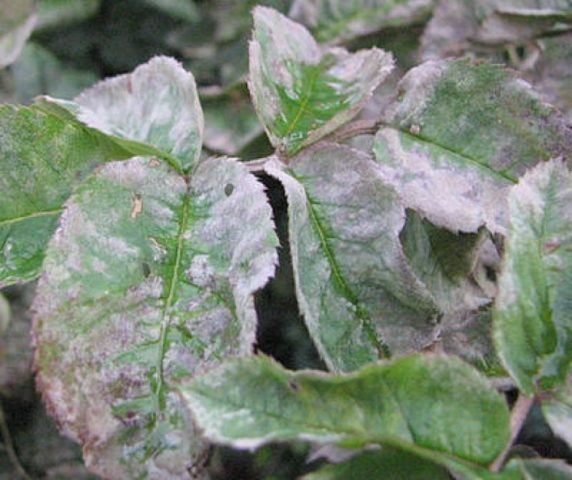
To get rid of a fungal disease, the John Franklin rose should be watered with a solution of copper sulfate
The main reasons for the appearance of the disease are landing in a poorly lit, inaccessible place for the wind. Excess moisture, temperature changes and lack of maintenance are a favorable environment for bacteria.
Application in landscape design
Since the bushes of the John Franklin rose are erect, the variety can be used both in a single planting and placed next to other roses.
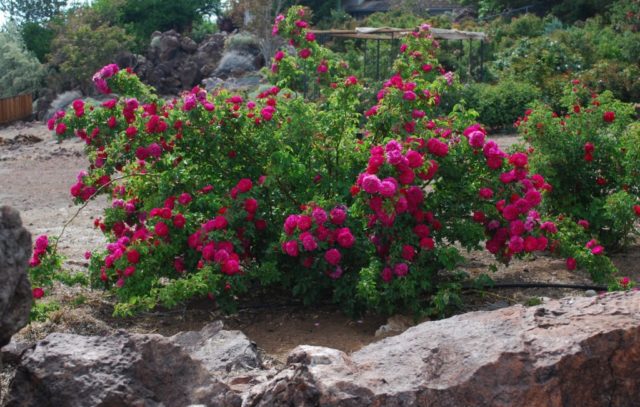
The rose looks good in stone fences, near gazebos, in parks
You can place the flower next to other varieties, against the background of conifers. A rose is planted by John Franklin and along the fences, placed in mixborders.
Conclusion
Rose John Franklin is a representative of the Canadian park species. The hybrid is unpretentious, frost-resistant. With proper care, it pleases with abundant flowering during the summer season. This feature allows the John Franklin hybrid to be used both in landscaping public places and private gardens.
Reviews of the Canadian park rose John Franklin
